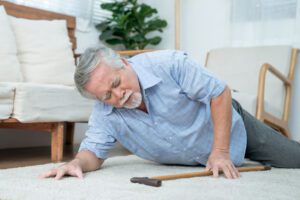A Step-By-Step Guide for How to Get Up from a Fall
 Falls can be serious business for seniors – unfortunately, they’re more common than you might realize. The CDC says more than 1 in 4 people 65 and older fall annually. Interestingly, if you fall just once, your chances of falling again double.
Falls can be serious business for seniors – unfortunately, they’re more common than you might realize. The CDC says more than 1 in 4 people 65 and older fall annually. Interestingly, if you fall just once, your chances of falling again double.
Also, if older adults stay on the floor for too long or get up incorrectly, they could cause additional injury, even if they didn’t get injured seriously when they initially fell. For example, while on the ground, they could develop serious complications such as pneumonia, dehydration, hypothermia, or even pressure sores. Falls also create a sense of fear in seniors, sometimes causing them to take unnecessary precautions (such as avoiding daily activities) to be sure they don’t fall again in the future. The problem is that when someone is less active, they become weaker and more susceptible to a fall.
To remedy the fear and danger of falling, it’s wise for seniors to proactively learn safe techniques for how to get up from a fall. This will instill them with confidence that if they do fall, they’ll be equipped to get up on their own and/or minimize injuries. However, it’s important to note that they should only consider getting up from a fall if they’re not injured or dizzy – and only if they’re strong enough to pull themselves up. Additionally, seniors with limited mobility or severe health conditions should always check with their therapist or physician for advice on what to do should they experience a fall.
If you’re the one who finds your older adult on the floor, be sure to first assess injuries before trying to move him or her, or you could worsen injuries. Instead, call 911 and keep the person warm and comfortable while waiting for emergency responders to arrive.
Below is a step-by-step guide for seniors on the proper way to get up from a fall:
How to get up from a fall when there are no injuries:
1. Don’t try to move for at least a few minutes; moving too quickly can cause more harm. Instead, stay calm and still.
2. Slowly move your hands, feet, arms, and legs to check for pain and determine if you’re injured.
3. Once you’ve determined you’re not injured, slowly begin rolling onto your side. Start by moving your head to that side, then roll your opposite arm over to that side, followed by your opposite leg. Once you’re fully on your side, take a moment to rest.
4. Slowly push yourself up into a crawling position and crawl gently on your hands and knees over toward a sturdy piece of furniture or chair. Don’t rush; move at a pace you can handle. Then, place your hands on the furniture, one at a time.
5. Supporting yourself with your hands, bring your most muscular leg up to a 90-degree angle by putting that foot flat on the ground while keeping the other leg kneeling. Using both arms and legs, slowly push up to a standing position.
6. Slowly move towards the nearest chair (if that’s not the piece of furniture you’re using to support you), and turn around while slowly lowering yourself onto the chair. Before doing anything else, sit and catch your breath.
How to call for help when there are injuries:
1. Rest briefly before doing anything while remaining as calm as possible. Then, slowly start moving parts of your body to determine which parts are injured.
2. If you have a mobile phone or emergency medical alert device nearby, use it to call 911 or a nearby family member. Tell them about your injuries and ask for help.
3. If you don’t have a phone or emergency medical alert device nearby, start yelling for help as loudly as possible. If you don’t have the energy to yell, grab whatever you can find nearby (a cane, a metal object, etc.) and use it to start banging on nearby furniture or even the floor to attract attention.
4. Keep yourself warm while you wait for help. Put a pillow underneath your head if there’s one nearby. Cover yourself with a blanket or extra clothing if you can reach any.
Suppose seniors arm themselves with knowledge about and practice getting up from a fall before the event happens. In that case, they’ll be much better physically and emotionally equipped when or if they experience an actual fall. For more information on the above steps, watch this five-minute video.
Of course, an ounce of prevention is always worth a pound of cure. It’s far safer and wiser to prevent a fall in the first place than it is to figure out how to get up from a fall. The problem is that when family members don’t live in the same home as their older loved one, it’s often difficult to know how she/he is truly getting along at home.
Gardeen is the most effective, noninvasive tool on the market for families to gain insight into their older adult’s well-being. This comfortable bracelet tracks the wearer’s daily activities and provides accurate data, including reports on activity level, falls, sleep, and much more. This data allows the user and their family to have peace of mind or make informed decisions about adding care if appropriate. For more information on Gardeen, call 617-232-0042.
